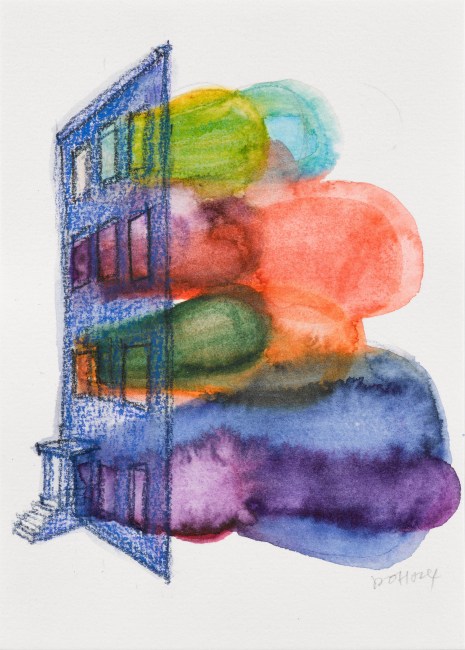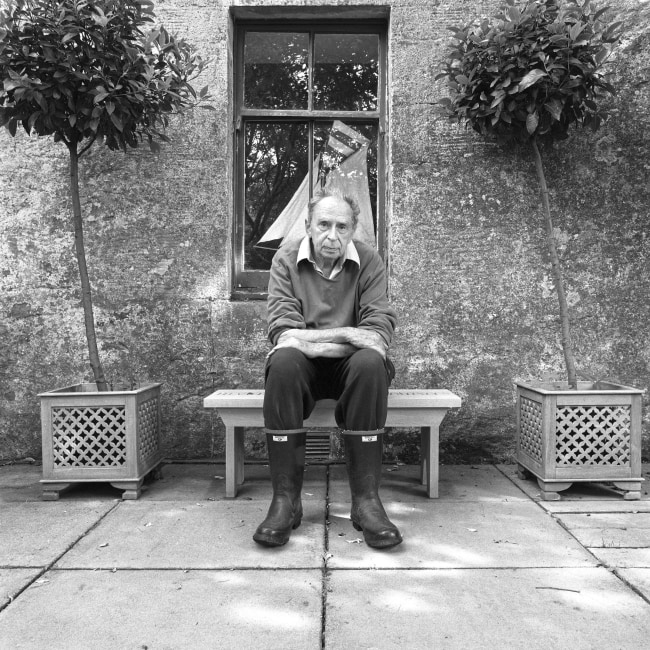The Houses is a series of new wall-based works by Alex Hartley inspired by iconic examples of modernist domestic architecture.
Alex Hartley’s work addresses complicated and sometimes contradictory attitudes toward the built and natural environments, showing us new ways of physically experiencing and thinking about our constructed surroundings. In The Houses he brings together photographic and overlaid painterly elements to examine the idea of the viewpoint, the frame and the boundary – between interior and exterior, manmade and natural environments, public and private space, two and three dimensions. Iconic examples of modernist domestic architecture, photographed by the artist over the past twenty-five years, primarily in Los Angeles, form the basis of these atmospheric monochrome works, in which the photographic image lies separated beneath hand-painted elements – describing and embellishing a verdant landscape – applied directly to a layer of semi-transparent acrylic.
Examples include several of the houses that were developed as a result of the Case Study Program, experiments in American residential architecture sponsored by Arts & Architecture magazine, which ran intermittently from the mid-1940s until the mid-1960s, and which changed the careers of Richard Neutra, Pierre Koenig and, to some extent, Charles and Ray Eames. Immortalised through the iconic black-and-white photography of Julius Schulman, these houses helped to redirect the course of twentieth-century domestic architecture. Works on display include Case Study #22 Stahl House, 2018, featuring Koenig’s famous building, a favourite of the artist, sited in the Hollywood Hills overlooking Los Angeles; Case Study #8 Eames House (West Elevation), 2018; and Case Study #8 Eames House (Entrance), 2018, featuring the building designed by Charles and Ray Eames for their home and studio, which has been revisited in Hartley’s work many times, and in various materials and formats, over the course of his career. The sole European example on show is Mies van der Rohe’s 1930 Villa Tugendhat in Brno, Czech Republic – a paragon of modernist architecture which is now designated a UNESCO World Heritage Site.
Encapsulated in The Houses are conflicting ideas of the modernist ideal and its legacy, these decades-old beacons of progression – architectural, cultural, social – appearing spectral, dreamlike, perhaps melancholic in their delicate greyscale tones. Caught up in them, too, are Romantic ideas of the picturesque as seen also in Hartley’s ongoing Ruin series, such as his architectural intervention for Wharf Road’s waterside garden, A Gentle Collapsing II, 2016, which, resembling an International Style domestic building apparently abandoned to the elements, offers poignant reflection on themes of entropy and decay. While The Houses are intact, yet to be reclaimed by nature, they are preserved only through the concerted efforts of human intervention.
The works hinge on the glass-walled pavilion giving rise to the desire for boundaries of other kinds and an ensuing sense of disquiet between architecture – angular, airily modern – and nature which, as evoked by the artist, often appears to engulf and overcome the depicted buildings, heightening a sense of voyeurism. The source material for the series commenced while Hartley was living in California at the beginning of the 2000s. Often frustrated by the fences and hedges that have grown up to screen these buildings since their construction half a century ago, the artist found himself ensnared in trees and undergrowth in a bid to capture the ideal image. This in turn led to his 2004 book LA Climbs: Alternative Uses for Architecture, in which Hartley went a step further by climbing the buildings themselves and recording his unconventional routes through the city. While modernist architecture has been a constant touchstone, amplified in Hartley’s recent work is a sense of narrative, of the viewer having arrived at a situation of ambiguous cause and uncertain outcome.












